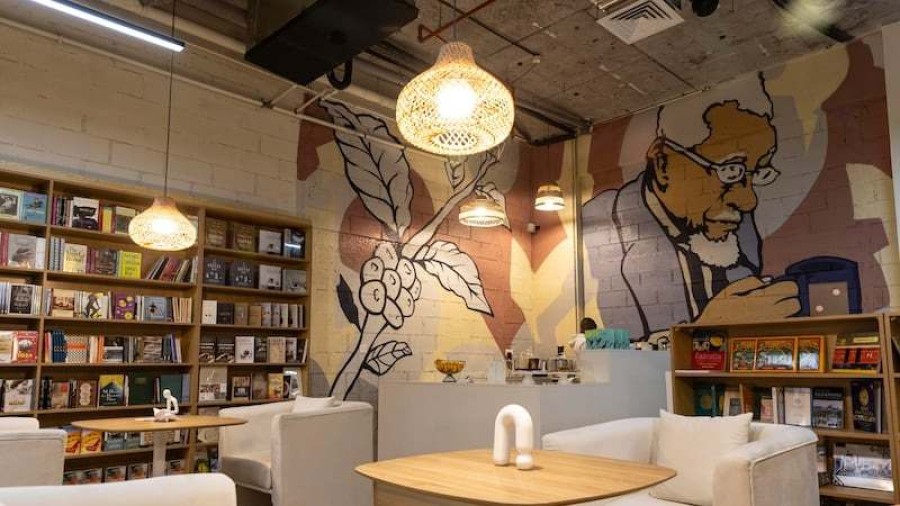How Dubai's Kutubna Cultural Centre Became More Than Just an Independent Bookstore
20 August, 2024

For Shatha Almutawa, launching Kutubna Cultural Centre has been akin to receiving “a second PhD and a more important one”. It has familiarised her with the Gulf’s literary and artistic scene in a way that she could never have had while living abroad.
Shatha Almutawa's Kutubna Cultural Centre in Dubai has evolved from a simple bookstore into a vibrant cultural hub. It officially launched with "One Hundred Years of Painting," showcasing 27 works from renowned Arab artists.
The Emirati-Kuwaiti historian returned to the UAE from the US in 2022, shortly after the birth of her daughter. Almutawa had been teaching Islamic intellectual history at the American University in Washington DC. She had spent more than two decades studying and working in the US but wanted to move back to the region so that her daughter would grow up with her family.
Yet, Almutawa wanted to sustain her academic practice, but in a less institutional format. She sought to open a bookshop, one dedicated to books from the Gulf. It was her way of reading works from the region she wasn’t exposed to in the US.
Kutubna Cultural Centre is very much a bookstore at its core, but since marking a soft opening last year, it has blossomed into something larger. The centre will now hold its official launch through One Hundred Years of Painting: Arab Art from 1916 to 2017, an exhibition that opened on Saturday and runs until October 13.
Almutawa says she never expected the cultural centre to encompass all it does today. When she came up with the idea, she had thought about a space reminiscent of Cairo’s street side bookshops. However, as she managed to secure a sprawling space in Nadd Al Hamar and began applying for a license, her initial idea soon became a more ambitious project.
“When I went to apply for the bookshop license, I learnt that you can't do events like author readings, book signings and writing workshops. For that, we would need a license for a cultural centre,” she says.
Almutawa was initially dismayed at the fact that Kutubna’s signboard would read ‘cultural centre’ instead of ‘bookshop’. She thought the former may come across as uninviting. However, artists, academics and writers soon began reaching out, interested in what one of Dubai’s newest cultural spaces had to offer.
“People were driving from all over the UAE,” she says. “They had ideas for the centre, and they wanted to help. So from the beginning, the place was really built by volunteers and people who really believe in having a community space for artists and writers.”
This communal effort was pivotal in bringing the Kutubna Cultural Centre to fruition, especially, as Almutawa says, considering the scant budget they had to work with.
“There was no budget to start with. It was completely bare minimum, not even,” she says. “But we did it. It just required some scavenging. The glass panels are discarded from another shop. The lights are taken from a grocery store that had closed down. The doorknobs, toilets and sinks don’t match.”
Yet, these idiosyncrasies are what gives the cultural centre its charm, making it a welcoming place for its bustling programming.
Since its soft launch, the centre has hosted several renowned local academics. These include Ahmed Al Maazmi, who highlighted the role that enslaved individuals in Oman played in preserving manuscripts in the 19th century, and how in the practice of copying documents, they became writers themselves. Abdulla Galadari, meanwhile, led a lecture that compared and contrasted Jewish texts with the Quran.
In both those cases, the turnout was inspiring and cemented Almutawa’s ambitions with the cultural centre. Though Kutubna has been up and running since September, Almutawa says the centre only began truly finding its final form over the past week, with new walls being fitted as it prepares to host its inaugural exhibition.
One Hundred Years of Painting features 27 works by some of the region’s most celebrated artists. The paintings have been drawn from two collections of Arab art in Dubai: the International House Group collection and Al Noon Residence collection.
The oldest painting in the exhibition is A view from Tigris River by Iraqi artist Abed Al Kader Al Rassam. As its title suggests, the painting depicts the calm waters of the Tigris with a traditional house at its bank.
A pair of works by Saliba Douaihy, meanwhile, shows the development of the Lebanese artist’s style over the years, going from a smaller, landscape work The Monastery, painted in 1925, to the abstraction that informs View of Qannoubine Valley, which was made in 1972.
The exhibition also includes works by Farid Aouad, Amine El Bacha, Shakir Hassan, Emanuel Guiragossian, Michel El Mir, Fateh Moudarres, Georges Sabbagh and Najat Makki, among others.
Almutawa says organising the exhibition helped hone her appreciation of Arab art and delve more into its history, adding that she hopes it will inspire the centre’s visitors the same way.
“I didn't know very much about these pieces or these artists,” she says. “Over time, I started to learn and understand.”
Source: www.thenationalnews.com
TAG(s):
